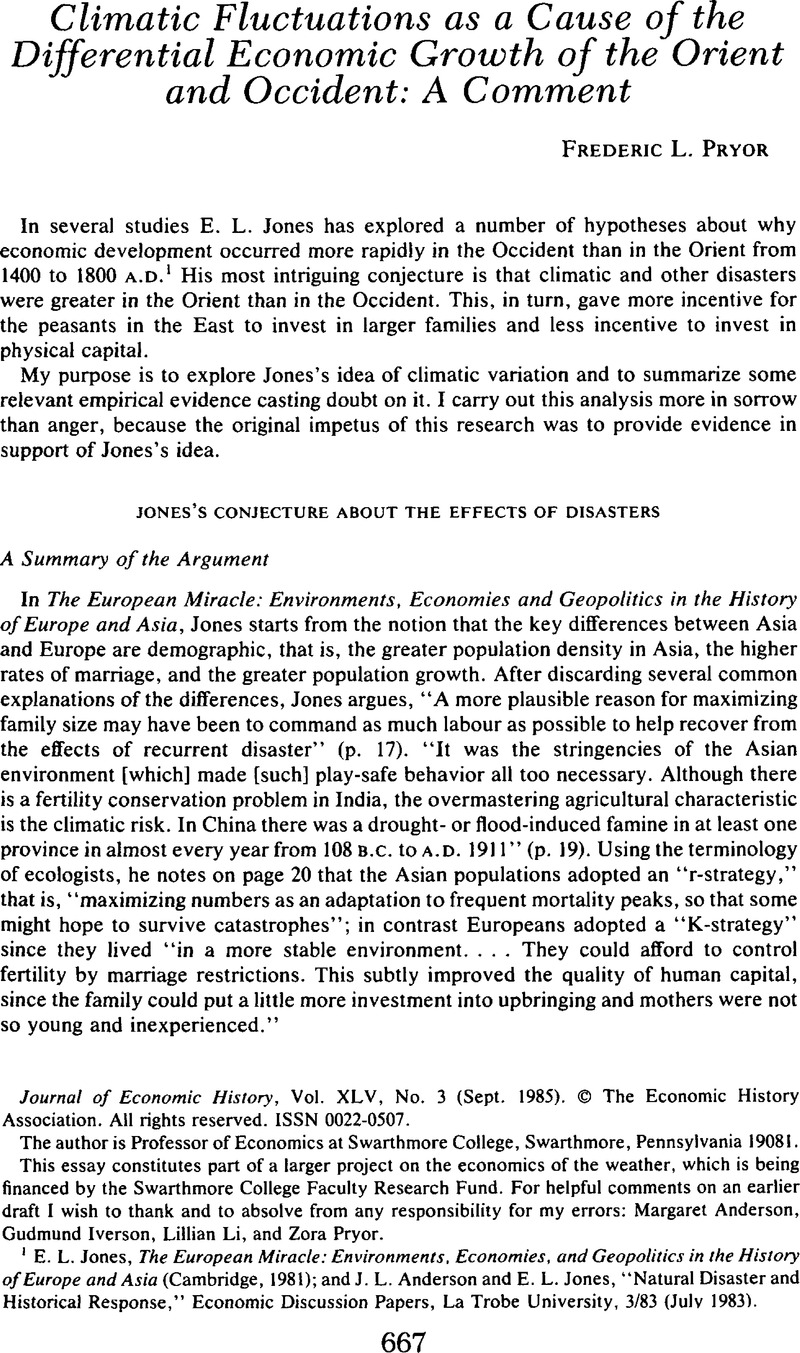Article contents
Climatic Fluctuations as a Cause of the Differential Economic Growth of the Orient and Occident: A Comment
Published online by Cambridge University Press: 03 March 2009
Abstract

- Type
- Notes and Discussion
- Information
- Copyright
- Copyright © The Economic History Association 1985
References
This essay constitutes part of a larger project on the economics of the weather, which is being financed by the Swarthmore College Faculty Research Fund. For helpful comments on an earlier draft I wish to thank and to absolve from any responsibility for my errors: Margaret Anderson, Gudmund Iverson, Lillian Li, and Zora Pryor.Google Scholar
1 Jones, E. L., The European Miracle: Environments, Economies, and Geopolitics in the History of Europe and Asia (Cambridge, 1981);Google Scholar and Anderson, J. L. and Jones, E. L., “Natural Disaster and Historical Response,” Economic Discussion Papers, La Trobe University, 3/83 (07 1983).Google Scholar
2 The data come from Lamb, H. H., Climate: Present, Past and Future (London, 1977), vol. 2;Google Scholar the conclusions about investment come from Pollard, Sidney, Peaceful Conquest: The Industrialization of Europe, 1760–1970 (Oxford, 1981). If China at that time had proportionally as many flood deaths, they would have amounted to about 70,000,000.Google Scholar
3 All historic demographic data used here came from McEvedy, Colin and Jones, Richard, Atlas of World Population History (New York, 1978).Google Scholar The year 1400 is a misleading starting date for the Occident since Europe was just climbing out of the population trough occasioned by the plagues of the fourteenth century. And 1800 is a misleading date for both the Occident and Orient since their populations had just begun to soar and the differential timing of the population upsurge influences the results of average population growth calculations.
4 Data on war deaths for Europe on a decade basis come from Wright, Quincy, A Study of War (2nd ed., Chicago, 1965).Google Scholar Data on deaths from major earthquakes, tornadoes, avalanches, tsunami, cyclones, and volcanic eruptions come from Cornell, James, The Great International Disaster Book (New York, 1979) and were standardized with population data from McEvedy and Jones, Atlas.Google Scholar Comparisons were made between these geophysical disasters occurring in West and Central Europe on the one hand and China and India on the other hand. Of course, Cornell's discussion focuses only on a short list of the most important of such disasters occurring over the centuries; however, per capita death rates arising from these causes appear very low, even when the data are multiplied by some factor such as 5 to reflect the understatement of total deaths arising from all such geophysical disasters. Unfortunately, no data are available on the dimensions of damage to physical capital arising from these causes.
5 Sen, Amartya, Poverty and Famines: An Essay on Entitlements and Deprivation (London, 1981).Google Scholar
6 The raw data for these comparisons come from: World Meteorological Organization, Climatological Normals (CLINO) for Climate and Climate Ship Stations for the Period 1931–1960 (Geneva, 1971), and Climatological Normals, 1900–1930 (mimeo, Washington, D.C., 1949), nos. 1– 53. I defined the rainfall fluctuations in each nation in terms of the averages from those weather stations for which data were available in both periods, which meant that only 30 nations could be used in the study. The conclusions summarized in the text came from tests examining differences between the means of various rainfall statistics for a 30-nation sample.Google Scholar
7 The data on these matters leave something to be desired since some of the greatest differences in the rankings of nations with regard to rainfall fluctuations occurred either for countries where there were low-quality or limited data in the early period (that is, where there were only a few weather stations).Google Scholar
8 The use of this measure of fluctuations is based on several considerations that deserve to be made explicit. I assume that the agricultural systems of most nations can deal successfully with a certain amount of rainfall variation; it is only extreme variation that may give rise to difficulties. Further, it is the percentage difference of the extremes from the average that denotes the stress placed on the system, rather than the absolute differences between the extremes. It is unfortunate that there does not seem to be any empirical evidence to test either the validity of these assumptions or the appropriateness of the measure chosen.Google Scholar
9 The data for China come from a different source than the rest (namely the U.S. Department of Commerce cited in the table) and, for certain stations, cover a period less than 30 years. Therefore, it is possible that the “ratio of extremes” presented in the table somewhat understates the true ratio; however, the margin of error should not be great.Google Scholar
- 1
- Cited by




